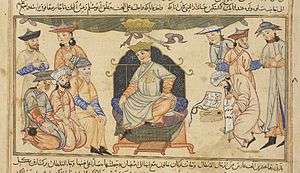Barkiyaruq
Abu al-Muzaffar Rukn ud-Din Barkyaruq ibn Malikshah (Persian: ابو المظفر رکن الدین برکیارق بن ملکشاه), better known as Barkyaruq (برکیارق). The Turkic word Berk Yaruq means (firm, unwavering light),[1] was the sultan of the Seljuk Empire from 1092 to 1105.
| Barkiyaruq | |
|---|---|
 Miniature of Barkiyaruq | |
| Sultan of the Seljuk Empire | |
| Reign | 1092–1105 |
| Predecessor | Mahmud I |
| Successor | Malik-Shah II |
| Born | 1079/1080 |
| Died | 1105 (aged 25) Borujerd |
| Issue | Malik-Shah II |
| House | House of Seljuq |
| Father | Malik-Shah I |
| Religion | Sunni Islam |
Early life
Barkiyaruq was born in 1079/1080,[2] the oldest son of Malik-Shah I[3] and a Seljuk princess. He had five brothers: Mahmud I, Ahmad Sanjar, Muhammad I Tapar, Dawud, and Abu al-Qasim.
During his youth, the succession to the Seljuk Sultanate was complicated by the death of two of his half-brothers: Dawud (died 1082) and Ahmad (died 1088), whom both were sons of the Kara-Khanid Princess Turkan Khatun, she also had a son named Mahmud (born 1087) which she wanted to succeed his father, while the vizier Nizam al-Mulk and most of the Seljuk army was in favor of Barkiyaruq.[4] Turkan Khatun then allied with Taj al-Mulk Abu'l Ghana'im to try to remove Nizam from his post. Nizam was assassinated in 1092, which made Barkiyaruq lose a powerful supporter. Barkiyaruq's father eventually died some months later. Turkhan Khatun then took the opportunity of his death, and with the support of Taj al-Mulk, put her 4 year old son, Mahmud I, on the throne, while Barkiyaruq was proclaimed as Sultan of the Seljuk Empire at Ray by the faction of the late vizier Nizam al-Mulk.
Reign
However, Mahmud I was not the only Seljuk claimant to the throne, several other Seljuk princes such as Arslan-Argun, Muhammad I Tapar, and Tutush I, also claimed the throne.[5] Taj al-Mulk was later assassinated by the ghilmans of Nizam al-Mulk,[6] while Turkhan Khatun and her son Mahmud I died in 1094. One year later, Barkiyaruq clashed with Tutush I at Ray, where Barkiyaruq managed to emerge victorious and kill Tutush I along with his supporter Ali ibn Faramurz.[7]
In 1105, Barkiyaruq died in Borujerd, and was succeeded by his son Malik-Shah II.
Affairs of the Empire During His Reign
During Barkiyaruq's short reign, he had five viziers, three of them were the children of Nizam al-Mulk: Izz al-Mulk Husain, Mu'ayyid al-Mulk and Fakhr al-Mulk.[8] The two other viziers were Abd-al-Dihistani Jalil and Khatir al-Mulk Abu Mansur Maybudi. During his reign, Barkiyaruq mostly focused on a way to find money to keep the expenses of the state.
References
- Bosworth 2001, p. 305.
- Bosworth 1968, pp. 220-221.
- Van Donzel 1994, p. 464.
- Bosworth 1968, pp. 68-80.
- Lewis 2003, p. 51.
- Bosworth 1968, p. 57.
- Bosworth 1968, p. 38.
- Bosworth 1968, p. 105.
Sources
- Bosworth, C. E. (1968). "The Political and Dynastic History of the Iranian World (A.D. 1000–1217)". In Frye, R. N. (ed.). The Cambridge History of Iran, Volume 5: The Saljuq and Mongol periods. Cambridge: Cambridge University Press. pp. 1–202. ISBN 0-521-06936-X.CS1 maint: ref=harv (link)
- Bosworth, C.E. (2001). Notes on Some Turkish Names in Abu 'l-Faḍl Bayhaqī's Tārīkh-i Masʿūdī. Oriens. Vol. 36. Brill.CS1 maint: ref=harv (link)
- Lewis, Bernard (2003). The Assassins: A Radical Sect in Islam. Basic Books Inc.CS1 maint: ref=harv (link)
- Van Donzel, E. J. (1994). Islamic Desk Reference. E.J.Brill.CS1 maint: ref=harv (link)
| Preceded by Mahmud I of Great Seljuk |
Sultan of Seljuq Empire 1092–1105 |
Succeeded by Malik Shah II |